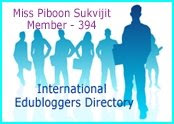Thursday 26 June 2008
Melinda and I had a difficult time explaining possessive "'s" to the students. We could tell from their responses. The teacher explained that some languages don't have possessive forms such as Spanish. She herself speaks four languages-Spanish, Japanese, English and another language. Anyway, she had to communicate with the Colombian students at times when they could not understand the subject matters. Unfortunately for the Arabic students, they dominate the class when none of us teachers don't know how the language. Here, I think it's beneficial for any teachers to be able to speak the same language as their students who are in a lower level (even just a bit) in order to get messages across and communicate more effectively.
We tried very hard to explain the differences between "'s" which refers to the possessive form and "'s" which refers to the contraction form for "is." Good thing we had a class of 8, so we were able to drill it and asked students one-on-one. Melinda even drew a family tree to explain one of the exercises about family that had possessive and possessive pronouns embedded in it. I thought that was good and I would have done the same. Students need to see the language in writing; it's more effective this way particularly with beginners.
In this class, I learned some helpful bit and pieces from the teacher's teaching style; for instance, she would never discourage her students in answering questions. For example, when she asked Student A to answer a question, but Student B interrupted and answered it for Student A, the teacher repeated the answer from Student B to Student A and moved on to the next question. I myself often find it irritating and impolite when students do such thing, so I try to stop them from doing so and to teach them to take turn. Melinda, on the other hand, would appreciated the contribution from Student B, then she threw a new question to him because, obviously, he showed his interest in participating the activity. I talked to her after class about the matter, and therefore I understood that it's important to encourage them to talk and support their doing. However, it's also crucial to explain the good manners in a classroom when the action gets out of hand. Students will become demotivated when they are stopped from expressing their opinions or their opinions are devalued or depreciated. In this case and level, we should put it into consideration that they are still new to the country and culture. It also depends on the teacher's discretion whether or not they deliver such action purposely. If so, the teacher might have to stop them and explain.
On Friday, the students were introduced to new grammar, which was preposition. Melinda found pictures that demonstrate the position with an object-"on", "in", "under", "next to", "in front of", etc. I suggested to some students I saw translating the words in their languages that they memorise them by the pictures. This way they did not have to depend on their dictionary or their mother language to translate the words. Then, students had a Grammar and Vocabulary test. My role here was explaining the answers to the students after they finished. Many of them were very frustrated since they could not finish the test in time. I thought perhaps they were right. A 25-minute test for 40 questions might not be adequate for beginners.
In the afternoon, I had a meeting with Suzanne, Marketing Manager, about the collaboration between SPU and GU. She said that she would try to tailor a program for our students, so they could perhaps come to study with GELI and travel. She also told me about meeting with Dr.Gloria and some faculty members from Liberal Arts. They also told her about their wishes as well in terms of collaboration. I think at least I have put my best foot forward, so when things go as plan we could just hit the ground running.
One of the thing, the best thing I thought, that I learned today was about a performance development/ performance reviews (or some people might rephrase it as "assessment"). I had a conversation with Judy, the Manager, about her day, and she explained that she had a couple meetings with her staff on their performances at work, their expectations, and problems at work. Judy would talk to them about the problems that they are having (mostly giving constructive criticism) or the organization is having, then she would ask them to post any productive ideas Taking for about half an hour talking to her staff one-on-one gave her the significant opportunity to help them improve their work performances and accomplish their goal. She interviewed each one of them what their plans for the future, their plans for career development or goals that they would like to accomplish, things that they have done and things that they have not done and yet to be accomplished in the near future. She found that it's vitally beneficial to both the organization and the staff themselves; therefore, she could provide the right assistance or solution. Discussing problems might seem a bit uncomfortable for both parties for some people; however, it sure is a half an hour worth of better understanding, better management, and productive progress! A two-way communication plays a dynamic role in a workplace indeed.
Thursday, June 26, 2008
Meeting with Suzanne and a Great Management!
Subscribe to:
Post Comments (Atom)







No comments:
Post a Comment